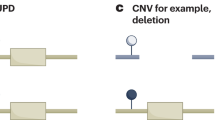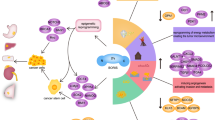Abstract
Loss of imprinting (LOI) is an epigenetic alteration of some cancers involving loss of parental origin-specific expression of imprinted genes. We observed LOI of the insulin-like growth factor-II gene in twelve of twenty-seven informative colorectal cancer patients (44%), as well as in the matched normal colonic mucosa of the patients with LOI in their cancers, and in peripheral blood samples of four patients. Ten of eleven cancers (91%) with microsatellite instability showed LOI, compared with only two of sixteen tumors (12%) without microsatellite instability ( P < 0.001). Control patients without cancer showed LOI in colonic mucosa of only two of sixteen cases (12%, P < 0.001) and two of fifteen blood samples (13%, P < 0.001). These data suggest that LOI in tumor and normal tissue identifies most colorectal cancer patients with microsatellite instability in their tumors, and that LOI may identify an important subset of the population with cancer or at risk of developing cancer.
This is a preview of subscription content, access via your institution
Access options
Subscribe to this journal
Receive 12 print issues and online access
$209.00 per year
only $17.42 per issue
Buy this article
- Purchase on Springer Link
- Instant access to full article PDF
Prices may be subject to local taxes which are calculated during checkout





Similar content being viewed by others
References
Ford, D., Easton, D.F. & Peto, J. Estimates of the gene frequency of BRCA1 and its contribution to breast and ovarian cancer incidence. Am. J. Hum. Genet. 57, 1457–1462 (1995).
Newman, B. et al. Frequency of breast cancer attributable to BRCA1 in a population-based series of American women. JAMA 279, 915– 921 (1998).
Deng, G., Lu, Y., Zlotnikov, G., Thor, A.D. & Smith, H.S. Loss of heterozygosity in normal tissue adjacent to breast carcinomas. Science 274, 2057– 2059 (1996).
Bisgaard, M.L., Fenger, K., Bulow, S., Niebuhr, E. & Mohr, J. Familial adenomatous polyposis (FAP): frequency, penetrance, and mutation rate. Hum. Mutat. 3, 121– 125 (1994).
Aaltonen, L.A. et al. Incidence of hereditary nonpolyposis colorectal cancer and the feasibility of molecular screening for the disease. N. Engl. J. Med. 338, 1481–1487 ( 1998).
Liu, B. et al. Mismatch repair gene defects in sporadic colorectal cancers with microsatellite instability. Nat. Genet. 9, 48–55 (1995).
Chetty, R., Naidoo, R. & Schneider, J. Allelic imbalance and microsatellite instability of the dcc gene in colorectal cancer in patients under the age of 35 using fluorescent DNA technology. Mol. Pathol. 51, 35– 38 (1998).
Thibodeau, S.N. et al. Microsatellite instability in colorectal cancer - different mutator phenotypes and the principal involvement of HMLH1. Cancer Res. 58, 1713–1718 ( 1998).
Kim, H. et al. Expression of HMSH2 and HMLH1 in colorectal carcinomas with microsatellite instability. Pathol. Res. Pract. 194, 3– 9 (1998).
Kim, H., Jen, J., Vogelstein, B. & Hamilton, S.R. Clinical and pathological characteristics of sporadic colorectal carcinomas with DNA replication errors in microsatellite sequences. Am. J. Pathol. 145, 148–156 (1994).
Brassett, C. et al. Microsatellite instability in early onset and familial colorectal cancer. J. Med. Genet. 33, 981– 985 (1996).
Bubb, V.J. et al. Microsatellite instability and the role of hMSH2 in sporadic colorectal cancer. Oncogene 12, 2641– 2649 (1996).
Lukish, J.R. et al. Prognostic significance of DNA replication errors in young patients with colorectal cancer. Ann. Surg. 227, 51–56 (1998).
Senba, S. et al. Clinicopathologic and genetic features of nonfamilial colorectal carcinomas with DNA replication errors. Cancer 82, 279–285 (1998).
Lynch, H.T. & Smyrk, T.C. Identifying hereditary nonpolyposis colorectal cancer. N. Engl. J. Med. 338, 1537–1538 (1998).
Feinberg, A.P. in The Genetic Basis of Human Cancer (eds. Vogelstein, B. & Kinzler, K.W.) 95 (McGraw-Hill, New York,1998).
Rainier, S. et al. Relaxation of imprinted genes in human cancer. Nature 362, 747–749 ( 1993).
Ogawa, O. et al. Relaxation of insulin-like growth factor II gene imprinting implicated in Wilms' tumour. Nature 362, 749–751 (1993).
Weksberg, R., Shen, D.R., Fei, Y.L., Song, Q.L. & Squire, J. Disruption of insulin-like growth factor 2 imprinting in Beckwith-Weidemann syndrome. Nature Genet. 5, 143–150 (1993).
Feinberg, A.P., Kalikin, L.M. & Johnson, L.A., Thompson, J.S. Loss of imprinting in human cancer. Cold Spring Harb. Symp. 59, 357–364 (1994).
Suzuki, H., Veda, R., Takahashi, T. & Takahashi, T. Altered imprinting in lung cancer. Nature Genet. 6, 332– 333 (1994).
Randhawa, G.S. et al. Loss of imprinting in disease progression in chronic myelogenous leukemia. Blood 91, 3144– 3147 (1998).
Boland, C.R. et al. National Cancer Institute workshop on microsatellite instability for cancer detection and familial predisposition: Development of international criteria for the determination of microsatellite instability in colorectal cancer (submitted).
Vu, T.H. & Hoffman, A.R. Promoter-specific imprinting of the human insulin-like growth factor-II gene. Nature 371, 714–717 (1994).
He, L. et al. Hypervariable allelic expression patterns of the imprinted IGF2 gene in tumor cells. Oncogene 16, 113– 119 (1998).
Issa, J.P., Vertino, P.M., Boehm, C.D., Newsham, I.F. & Baylin, S.B. Switch from monoallelic to biallelic human IGF2 promoter methylation during aging and carcinogenesis. Proc. Natl. Acad. Sci. USA 93: 11757– 11762 (1996).
Kitsbert, D. et al. Allele-specific replication timing of imprinted gene regions. Nature 364, 459–463 (1993).
LaSalle, J.M. & Lalande, M. Homologous association of oppositely imprinted chromosomal domains. Science 272, 725–728 (1996).
Aparicio, O.M., Billington, B.L. & Gottschling, D.E. Modifiers of position effect are shared between telomeric and silent mating-type loci in S. cerevisiae. Cell 66, 1279–1287 (1991).
Strahl-Bolsinger, S., Hecht, A., Luo, K. & Grunstein, M. SIR2 and SIR4 interactions differ in core and extended telomeric heterochromatin in yeast. Genes Dev. 11, 83–93 (1997).
Buck, S.W. & Shore, D. Action of a RAP1 carboxy-terminal silencing domain reveals an underlying competition between HMR and telomeres in yeast. Genes Dev. 9, 370– 384 (1995).
Brachmann, C.B. et al. The SIR2 gene family, conserved from bacteria to humans, functions in silencing, cell cycle progression, and chromosome stability. Genes Dev. 9, 2888–2902 (1995).
Feinberg, A. & Vogelstein, B. Hypomethylation distinguishes genes of some human cancers from their normal counterparts. Nature 301, 89–92 ( 1983).
Steenman, M. et al. Loss of imprinting of IGF2 in linked to reduced expression and abnormal methylation of H19 in Wilms' tumour. Nature Genet. 7:433–439, 1994.
Herman, J.G. et al. Incidence and functional consequences of hMLH1 promoter hypermethylation in colorectal carcinoma. Proc. Natl. Acad. Sci. USA 95, 6870–6875 (1998).
Suzuki, K. et al. Microsatellite instability in female non-small-cell lung cancer patients with familial clustering of malignancy. Br. J. Cancer 77, 1003–1008 ( 1998).
Sekine, I. et al. Microsatellite instability in lung cancer patients 40 years of age or younger. Jpn. J. Cancer Res. 88, 559–563 (1997).
Ottini, L. et al. Microsatellite instability in gastric cancer is associated with tumor location and family history in a high-risk population from Tuscany. Cancer Res. 57, 4523–4529 (1997).
Shinmura, K. et al. Stage-dependent evaluation of microsatellite instability in gastric carcinoma with familial clustering. Cancer Epidemiol. Biomarkers 6, 693–697 ( 1997).
Vogelsang, H.E. et al. Microsatellite instability and positive family anamnesis in patients with stomach carcinoma. Langenbecks Arch. Chir. Suppl. 114, 113–116 ( 1997).
Ohlsson, R. et al. IGF2 is parentally imprinted during human embryogenesis and in the Beckwith-Wiedemann syndrome. Nature Genet. 4 , 94–97 (1993).
Dietmaier, W. et al. Diagnostic microsatellite instability: definition and correlation with mismatch repair protein expression. Cancer Res. 57, 4749–4756 (1997).
Acknowledgements
We thank J. Barletta, R. Robinson and K. Romans for technical assistance; P. Kwiterovich for blood samples; M. Lee, J. Nathans, T. Kelly, C. Dang, and B. Chernow for discussions; and P. Rusche for manuscript preparation. This work was supported by NIH grants CA65145 (A.P.F) and CA62924 (S.R.H.).
Author information
Authors and Affiliations
Corresponding author
Rights and permissions
About this article
Cite this article
Cui, H., Horon, I., Ohlsson, R. et al. Loss of imprinting in normal tissue of colorectal cancer patients with microsatellite instability. Nat Med 4, 1276–1280 (1998). https://doi.org/10.1038/3260
Received:
Accepted:
Issue Date:
DOI: https://doi.org/10.1038/3260
This article is cited by
-
Insulin-like growth factor 2 (IGF2) expression in adrenocortical disease due to PRKAR1A mutations compared to other benign adrenal tumors
Endocrine (2021)
-
Overproduction of IGF-2 drives a subset of colorectal cancer cells, which specifically respond to an anti-IGF therapeutic antibody and combination therapies
Oncogene (2017)
-
Utilizing Gold Nanoparticle Probes to Visually Detect DNA Methylation
Nanoscale Research Letters (2016)
-
Carcinoma of the colon and rectum with deregulation of insulin-like growth factor 2 signaling: clinical and molecular implications
Journal of Gastroenterology (2016)
-
miR-615-5p is epigenetically inactivated and functions as a tumor suppressor in pancreatic ductal adenocarcinoma
Oncogene (2015)



